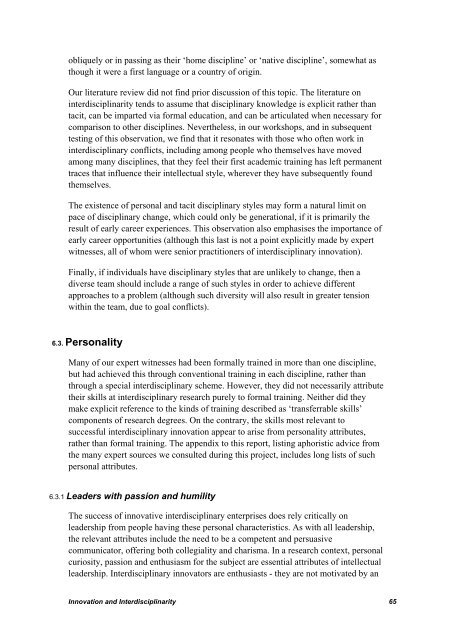Radical innovation: crossing knowledge boundaries with ...
Radical innovation: crossing knowledge boundaries with ...
Radical innovation: crossing knowledge boundaries with ...
Create successful ePaper yourself
Turn your PDF publications into a flip-book with our unique Google optimized e-Paper software.
obliquely or in passing as their ‘home discipline’ or ‘native discipline’, somewhat as<br />
though it were a first language or a country of origin.<br />
Our literature review did not find prior discussion of this topic. The literature on<br />
interdisciplinarity tends to assume that disciplinary <strong>knowledge</strong> is explicit rather than<br />
tacit, can be imparted via formal education, and can be articulated when necessary for<br />
comparison to other disciplines. Nevertheless, in our workshops, and in subsequent<br />
testing of this observation, we find that it resonates <strong>with</strong> those who often work in<br />
interdisciplinary conflicts, including among people who themselves have moved<br />
among many disciplines, that they feel their first academic training has left permanent<br />
traces that influence their intellectual style, wherever they have subsequently found<br />
themselves.<br />
The existence of personal and tacit disciplinary styles may form a natural limit on<br />
pace of disciplinary change, which could only be generational, if it is primarily the<br />
result of early career experiences. This observation also emphasises the importance of<br />
early career opportunities (although this last is not a point explicitly made by expert<br />
witnesses, all of whom were senior practitioners of interdisciplinary <strong>innovation</strong>).<br />
Finally, if individuals have disciplinary styles that are unlikely to change, then a<br />
diverse team should include a range of such styles in order to achieve different<br />
approaches to a problem (although such diversity will also result in greater tension<br />
<strong>with</strong>in the team, due to goal conflicts).<br />
6.3. Personality<br />
Many of our expert witnesses had been formally trained in more than one discipline,<br />
but had achieved this through conventional training in each discipline, rather than<br />
through a special interdisciplinary scheme. However, they did not necessarily attribute<br />
their skills at interdisciplinary research purely to formal training. Neither did they<br />
make explicit reference to the kinds of training described as ‘transferrable skills’<br />
components of research degrees. On the contrary, the skills most relevant to<br />
successful interdisciplinary <strong>innovation</strong> appear to arise from personality attributes,<br />
rather than formal training. The appendix to this report, listing aphoristic advice from<br />
the many expert sources we consulted during this project, includes long lists of such<br />
personal attributes.<br />
6.3.1 Leaders <strong>with</strong> passion and humility<br />
The success of innovative interdisciplinary enterprises does rely critically on<br />
leadership from people having these personal characteristics. As <strong>with</strong> all leadership,<br />
the relevant attributes include the need to be a competent and persuasive<br />
communicator, offering both collegiality and charisma. In a research context, personal<br />
curiosity, passion and enthusiasm for the subject are essential attributes of intellectual<br />
leadership. Interdisciplinary innovators are enthusiasts - they are not motivated by an<br />
Innovation and Interdisciplinarity 65

















